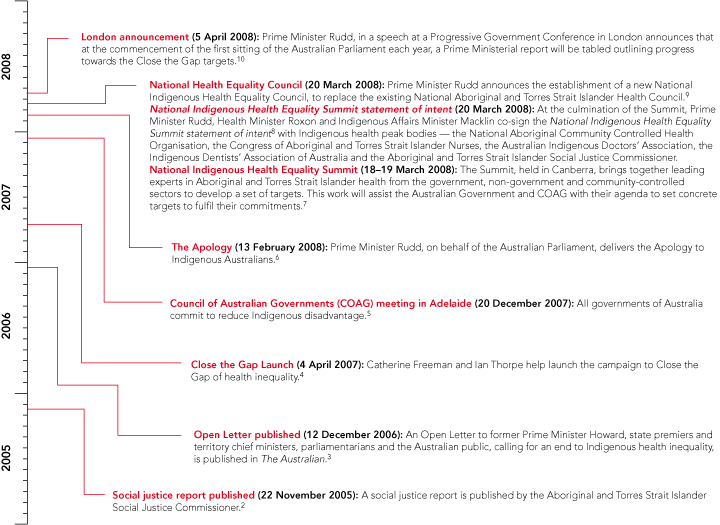It’s time for genuine partnerships as all Australians strive together to Close the Gap
A year ago in this Journal, Indigenous health leaders outlined the emergent health equality campaign for Aboriginal and Torres Strait Islander peoples,1 now known as the Indigenous Health Campaign or “Close the Gap”. An early indicator of the depth of support for Close the Gap was the large number of health, human rights, advocacy and community organisations that enthusiastically signed up or offered support for the campaign. Since then, the Indigenous Health Campaign coalition, led by Aboriginal and Torres Strait Islander health leaders and the Aboriginal and Torres Strait Islander Social Justice Commissioner, has worked in genuine partnership with non-Indigenous organisations. Key milestones along the Close the Gap campaign journey are shown in the Box.
They added:
The pathway to closing the gap is inextricably linked to economic development and improved education outcomes.5
We today take this first step by acknowledging the past and laying claim to a future that embraces all Australians. A future where this Parliament resolves that the injustices of the past must never, never happen again. A future where we harness the determination of all Australians, Indigenous and non-Indigenous, to close the gap that lies between us in life expectancy, educational achievement and economic opportunity. A future where we embrace the possibility of new solutions to enduring problems where old approaches have failed. A future based on mutual respect, mutual resolve and mutual responsibility. A future where all Australians, whatever their origins, are truly equal partners, with equal opportunities and with an equal stake in shaping the next chapter in the history of this great country, Australia.6
As stated in the Aboriginal and Torres Strait Islander Social Justice Commissioner’s 2005 report2 (the initial trigger for the genesis of the Close the Gap campaign), it is simply not defensible for governments and health and human services systems to argue that inadequate infrastructure, bureaucratic mechanisms or persistent complexity are justifiable speed humps to real change. It also does not hold that championing the rights of human beings is contrary to health gain.
The outcomes of the National Indigenous Health Equality Summit will be delivered by June 2008 to the Australian Government and COAG. The Summit deliberations will not only provide governments with a set of specific evidence-based targets for action and investment, but affirm the commitment to genuine partnership by signing the Statement of Intent (Box).8
- Tamara Mackean1
- Mick Adams2
- Sally Goold3
- Christopher Bourke4
- Tom Calma5
- 1 Australian Indigenous Doctors’ Association, Canberra, ACT.
- 2 National Aboriginal Community Controlled Health Organisation, Canberra, ACT.
- 3 Congress of Aboriginal and Torres Strait Islander Nurses, Bribie Island, QLD.
- 4 Indigenous Dentists’ Association of Australia, Canberra, ACT.
- 5 Human Rights and Equal Opportunity Commission, Sydney, NSW.
- 1. Wenitong M, Mokak R, Councillor H, et al. Rising to the health challenge for Aboriginal and Torres Strait Islander peoples: what will it take [editorial]? Med J Aust 2007; 186: 491-492. <MJA full text>
- 2. Calma T. Aboriginal and Torres Strait Islander social justice report 2005. Report of the Aboriginal and Torres Strait Islander Social Justice Commissioner. Canberra: Human Rights and Equal Opportunity Commission, 2005. http://www.hreoc.gov.au/social_justice/sj_report/sjreport05/index.html (accessed Apr 2008).
- 3. National Aboriginal Community Controlled Health Organisation, and 37 others. Open letter to the Prime Minister, State Premiers and Territory Chief Ministers, parliamentarians and Australian public. A call for health equality for Aboriginal and Torres Strait Islander peoples. The Australian 2006; 11 Dec. http://www.humanrights.gov.au/social_justice/health/health_OpenLetter.html (accessed Apr 2008).
- 4. Close the Gap Campaign Launch, 4 Apr 2007, Sydney. http://www.closethegap.com.au/information.php (accessed Apr 2008).
- 5. Council of Australian Governments’ Meeting, 20 December 2007. Melbourne: COAG, 2007. http://www.coag.gov.au/meetings/201207/index.htm (accessed Apr 2008).
- 6. Rudd K. Apology to Australia’s Indigenous Peoples, House of Representatives, Parliament House, Canberra [transcript]. 13 Feb 2008. http://www.pm.gov.au/media/Speech/2008/speech_0073.cfm (accessed Apr 2008).
- 7. National Indigenous Health Equality Summit. Fact sheet 3: progress so far. http://www.hreoc.gov.au/social_Justice/health/summit_2008_3.html (accessed Apr 2008).
- 8. Close the Gap. National Indigenous Health Equality Summit statement of intent. Canberra: IHES, 2008; 20 Mar. http://www.hreoc.gov.au/social_justice/health/statement_intent.html (accessed Apr 2008).
- 9. PM urged to focus on Indigenous health. Sydney Morning Herald 2008; 20 Mar. http://news.smh.com.au/pm-urged-to-focus-on-indigenous-health/20080320-20mb.html (accessed Apr 2008).
- 10. Annual Prime Ministerial statement on closing the gap [media release]. Canberra: Department of the Prime Minister and Cabinet, 2008; 5 Apr. http://www.pm.gov.au/media/Release/2008/media_release_0166.cfm (accessed Apr 2008).





